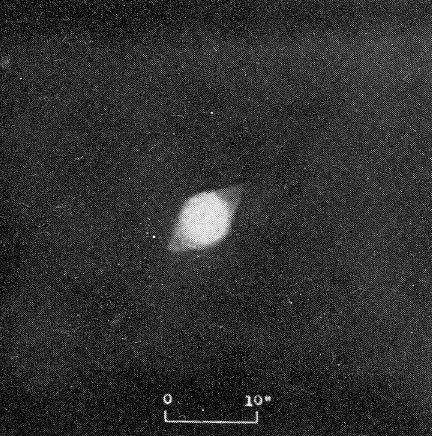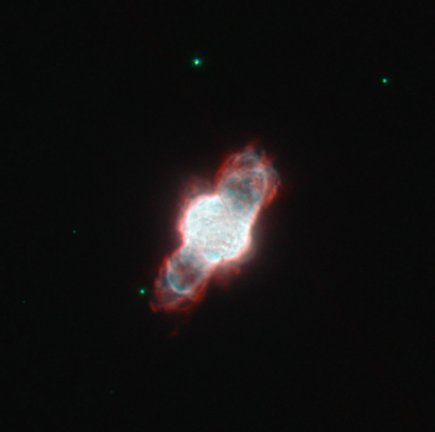NGC 6886
Located in a dense part of the Milky Way in
far eastern Sagitta 3 1/3 degrees west
of Gamma Sge (and more or less between
the Dumbbell Nebula and IC 4997), the compact
planetary nebula NGC 6886, though "quite
bright" [Curtis], remains something of a mystery thanks to a very
uncertain distance and a hidden central star. Curtis saw "a round
disk 6 [seconds of arc] in diameter, of nearly equal brightness
throughout...two wings bring the total length to about 9
[seconds]." The Hubble image on the right simply (though
gloriously) expands on Curtis's picture, revealing complex detail
in the "wings" that clearly surround the central structure.
Distance estimates run from 6000 light years (from various
individual methods) to as much as 17,000 l-y. Using a middle
"statistical" value of 10,000 l-y gives dimensions of 0.3 X 0.45
l-y, not unreasonable at all. Given NGC 6886's location and
distance, one might expect greater dimming of light by interstellar
dust than the approximate 1.4 magnitudes.
While the central star is not seen thanks to the glare of the
central structure, analysis of the nebular spectrum indicates that
it should have a visual magnitude of 19.0, faint indeed, most of
its radiation in the invisible ultraviolet. No wonder Curtis
claimed that "no central star could be made out." Along with
magnitude, we also find a substantial temperature of 168,000
Kelvin. Luminosity and condition then depend strongly on the
uncertain distance. At the middle value, a 0.58 solar mass star
with a luminosity of 1250 Suns (and what was
once the core of a much more massive giant) has reached its maximum
temperature and will shortly begin to cool and dim. (At the
shorter distance, the cooling has already commenced.) Lack of
chemical enrichment argues against a much higher mass. As the star
cools and the nebula expands (now between 20 and 25 kilometers per
second) and also dims, the star will emerge from its cocoon and
then die as a modest white
dwarf.
Left: Image by H. D. Curtis from Publications of the Lick
Observatory, Volume 13, Part III, 1918. Right: ESA/Hubble and
NASA.



